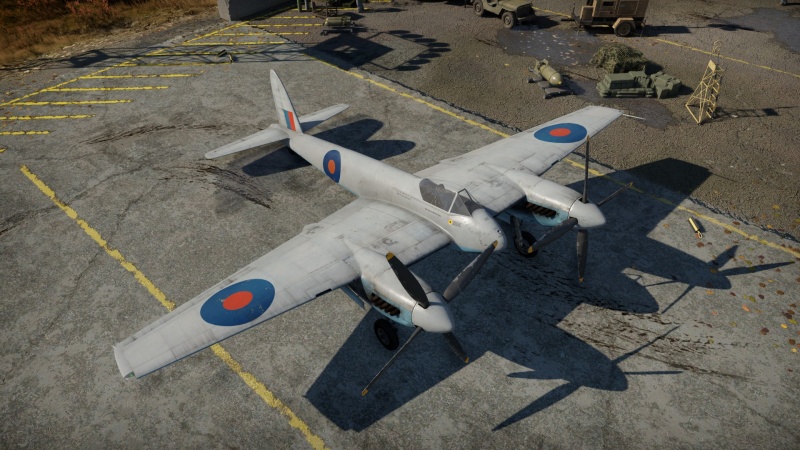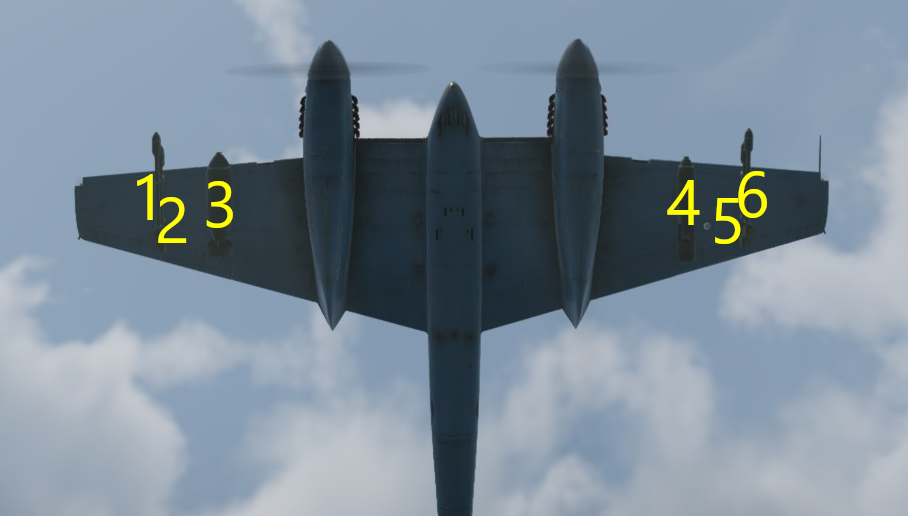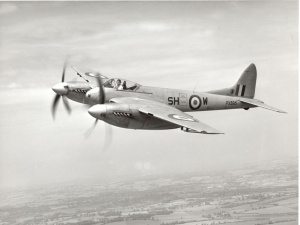Difference between revisions of "Hornet Mk.I"
(Edits) |
m (→See also) (Tag: Visual edit) |
||
| Line 218: | Line 218: | ||
* ''reference to the series of the aircraft;'' | * ''reference to the series of the aircraft;'' | ||
* ''links to approximate analogues of other nations and research trees.'' --> | * ''links to approximate analogues of other nations and research trees.'' --> | ||
| − | '' | + | '''Related development''' |
| − | * '' | + | * [[Hornet Mk.III]] |
| − | * | + | |
| + | '''Aircraft of similar configuration or role''' | ||
| + | |||
| + | * [[Ki-83]] | ||
| + | * [[F7F-1]] | ||
== External links == | == External links == | ||
Revision as of 18:05, 4 July 2024
| This page is about the premium British twin-engine fighter Hornet Mk.I. For the regular version, see Hornet Mk.III. |
Contents
Description
The de Havilland Hornet was a twin engine fighter developed by the de Havilland Company as a high altitude long range interceptor at the end of WWII. The Hornet saw most of its action in the colonies of the Pacific, its long range allowed it to cover large areas of sea and land in areas without proper infrastructure or services to maintain large fleets of aircraft. The Hornet Mk.I was the first variant of the Hornet with 60 units built. A total of 383 Hornets were built between all variants in the span of 5 years (1945-1950). It served in the Royal Air Force and Royal Navy from 1946 to 1956.
It was introduced in Update "Hot Tracks". The Hornet Mk.I represents the beginning of the end of British propeller aircraft. An earlier model of the tech tree Hornet Mk.III with a lighter airframe and the same engines, but lacking the "150 octane fuel" of the Mk.III, the Mk.I attains slightly more agility than its successor. With four fearsome 20 mm Hispano Mk.V cannons all mounted under the nose of the aircraft, it possesses the ability to shred apart whatever is unfortunate enough to fall within its sights. Able to climb and fight at high altitudes with a focus on energy fighting with only a lightly noticeable reduction in power that the Mk.III possesses. For any pilot willing to put the time in, this aircraft will provide a terrifying force in any battle, even ground scenarios with its ability to carry suspended armaments and armour piercing 20 mm rounds.
General info
Flight performance
For pilots who loved the Mosquito, the Hornet is a dream come true. As a descendant of the Mosquito FB Mk VI, it maintains many similarities to its older brother, namely an all-wooden construction and the iconic de Havilland tail design. However, the Hornet somehow manages to improve on the already excellent Mosquito platform, increasing speed, manoeuvrability, and armament while reducing overall aircraft proportions. From takeoff and into its flight, the Hornet is an overall smooth operator with brutal speed, reaching easily over 600 km/h in level flight at 4,000 m, insane climb rate, and excellent manoeuvrability for a twin-engined fighter. However, it's still a twin-engined fighter which means it can still be outmanoeuvred by most single-engined opponents it faces. Being a predecessor to the regular tech-tree variant Hornet Mk.III, its flight performance is slightly worse but barely noticeable.
The consideration in buying this plane should rely on the experience already gathered with other twin-engined fighters, although when flying this plane is mastered, it's excellent at grinding out the British prop-ranks.
| Characteristics | Max speed (km/h at 5,791 m) |
Max altitude (metres) |
Turn time (seconds) |
Rate of climb (metres/second) |
Take-off run (metres) | |||
|---|---|---|---|---|---|---|---|---|
| AB | RB | AB | RB | AB | RB | |||
| Stock | 716 | 696 | 26.4 | 27.5 | 19.1 | 19.1 | 500 | |
| Upgraded | 804 | 756 | 24.0 | 25.0 | 34.3 | 25.2 | ||
Details
| Features | ||||
|---|---|---|---|---|
| Combat flaps | Take-off flaps | Landing flaps | Air brakes | Arrestor gear |
| ✓ | ✓ | ✓ | X | X |
| Limits | ||||||
|---|---|---|---|---|---|---|
| Wings (km/h) | Gear (km/h) | Flaps (km/h) | Max Static G | |||
| Combat | Take-off | Landing | + | - | ||
| 826 | 370 | 356 | 287 | ~9 | ~4 | |
| Optimal velocities (km/h) | |||
|---|---|---|---|
| Ailerons | Rudder | Elevators | Radiator |
| < 420 | < 390 | < 450 | > 324 |
Survivability and armour
The pilot in the Hornet Mk.I is very well protected as propeller planes go, with armour both in front and behind the pilot providing layered protection to aim to make 'pilot sniping' much more difficult, even having spaced layers of steel behind to insure against penetrating rounds from tailing aircraft.
The Hornet Mk.I is built tough but with critical weaknesses in the layout of its internal components, the tail is almost entirely bereft of vital parts, only the rudder and tail controls being of significance meaning many rounds that do not break them will simply pass through with little damage. However a head-on or strike to the wings will result in a downed or seriously crippled aircraft with coolers, fuel, spars, and engines all packed tightly together. Pilots should exercise caution when engaging enemies that can strike head-on or above/below the hornet during positioning.
- 38 mm bulletproof glass - armoured windscreen
- 12.7 mm steel plate in front of cockpit
- 12.7 mm steel plate behind pilot
- 2 x 3mm steel box behind the cockpit
- All fuel is stored in the wings
- All critical components are in the front of the aircraft, with only tail controls in the rear
Modifications and economy
As a premium aircraft, all modifications are unlocked upon purchase.
Armaments
Offensive armament
The Hornet Mk.I is armed with:
- 4 x 20 mm Hispano Mk.V cannons, chin-mounted (190 rpg = 760 total)
The Mk.V Hispanos are a successor to the venerable and fearsome Hispano Mk.II's found on the Spitfires. With a fast fire rate and a comfortable ammunition load of 190 rpg, the trigger time afforded to the pilot is enough to allow adjusting for lead or harassing lighter aircraft without worrying overmuch about running dry. The ammunition available has an excellent air belt that is recommended at all times with a mixture of Armour-piercing Incendiary ammunition and High explosive incendiary shells. While a ground belt is available, it only provides up to 36 mm of penetration in ideal conditions which will not be adequate for most ground vehicles encountered at its BR. The air belt will still reliably destroy SPAA and light vehicles and be on hand for enemy aircraft who may engage.
All the guns are mounted beneath the chin of the Hornet Mk.I allowing for accurate and easy to lead fire with little if no need for convergence.
Suspended armament
The Hornet Mk.I can be outfitted with the following ordnance:
| 1 | 2 | 3 | 4 | 5 | 6 | ||
|---|---|---|---|---|---|---|---|
| 500 lb G.P. Mk.IV bombs | 1* | 1* | |||||
| 1,000 lb M.C. Mk.I bombs | 1* | 1* | |||||
| AP Mk I rockets | 2 | 2* | 2* | 2 | |||
| AP Mk II rockets | 2 | 2* | 2* | 2 | |||
| RP-3 rockets | 2 | 2* | 2* | 2 | |||
| * Bombs on hardpoints 3/4 cannot be equipped in conjunction with rockets on adjacent hardpoints | |||||||
| Default weapon presets | |
|---|---|
| |
The secondary loadout is very standard fare for the British aviation tree, a mid of 500 and 1000 lb 'dumb' bombs made available with AP and RP-3 rockets which experienced British pilots will have had many encounters with at this point. A mixture can be taken as the pilot wishes; owing to the role of the Hornet Mk.I it is not advisable to carry such in an air battle setting due to the performance impact and the presence of dedicated bomber craft. However, in ground RB the Hornet can strike at errant ground vehicles to assist its team before turn to maintain air superiority once its payload is spent.
The bomb payloads will be ample to knock out most if not all enemy ground vehicles the Hornet may encounter, the rockets may struggle greatly at its BR due to a maximum of only 100 mm of armour penetration from the AP Mk II rockets.
Usage in battles
Being a twin-engine fighter, it handles rather poorly when compared to single-engined fighters. It should not be expected to outmanoeuvre enemies, therefore you should really rely on your speed and try to keep your energy advantage. It might be possible to lure enemies into various manoeuvres where the excellent acceleration can be used to your advantage. If you have any experience from similar fighters like the Hornet Mk.III or any Mosquito, you can heavily use that to your advantage. Because the Hornet is an all-wooden construction, its ripping speed and maximum wing overload is rather low compared to other fighters.
When engaging fighters, a BnZ-playstyle should be used. One shouldn't commit to turning with the engaged enemy, because almost every plane, even light bombers will outturn you. The 4 x Hispano Mk.Vs mounted in the front of the plane with an ammo pool of 190 rounds per gun provide excellent firepower. The Hornet should be flown near friendlies because even when it can't get its guns on target, the enemy planes need to evade the bullets, therefore being an easy target to get picked off by allied planes nearby.
Because of its excellent climb rate, the Hornet can also be used as a bomber hunter. In his role, the main focus should lie on getting altitude to engage bombers from above, with far more speed than them. Do not try to spray your guns whilst being near the rear of the bomber, instead focus on one wing, then disengage after you've stricken the bomber.
Manual Engine Control
| MEC elements | ||||||
|---|---|---|---|---|---|---|
| Mixer | Pitch | Radiator | Supercharger | Turbocharger | ||
| Oil | Water | Type | ||||
| Controllable | Controllable Auto control available |
Not controllable Not auto controlled |
Controllable Auto control available |
Combined | Controllable 2 gears |
Not controllable |
Pros and cons
Pros:
- Excellent armament
- Very good climb rate
- Very fast, especially at high altitude
Cons:
- Poor roll and turn rates
- Wooden frame is vulnerable to fires and damage dealt from enemies
- Easily catches fire, the wings are littered with fuel tanks
History
The Hornet was developed by de Havilland after their success with the DH.98 Mosquito, also a twin engine aircraft but for strike missions. The development of the Hornet was a private venture of the company rather than a contract or an interest of the military in the concept. The development of the Hornet started after 1941 and concentrated in producing a long range fighter, this was designated DH.103. The aircraft was meant to be operated against the Japanese Empire in the Pacific Theatre.
The first prototype was ready in 1944 and that same year it conducted its first flight piloted by Geoffrey de Havilland Jr. A second prototype was built after that, being more similar to what would be the final version of the aircraft having provision for a pair of 200-gallon drop tanks and a pair of 1,000 lbs bombs on hard points underneath the wings. The RAF was interested in this new long range fighter, and once the production line for the Hornet was set and done, an order for 60 units was placed of the F.1 variant. These units were delivered by February 28, 1945.
Further variants of the Hornet were developed, but the most iconic one was the Sea Hornet. This variant was created with the idea of serving in aircraft carriers. This idea was possible thanks to the Hornet having good low speed handling and visibility for landings. Several modifications were made to the design, including a reinforcement of the lower rear fuselage, slotted flaps for better flaps down performance, catapult assisted takeoff compatibility with one forged steel catapult bridle hooks fitted below each wing close to the fuselage. However the most important modifications were the foldable wings, this was essential since the Hornet was a large fighter, and occupied a lot of space in storage.
Other variants were also produced, with some experimental ones fitting a search radar in the nose of the aircraft. However several reconnaissance versions were produced, some of which included photo-reconnaissance.
Media
- Skins
See also
Related development
Aircraft of similar configuration or role
External links
Paste links to sources and external resources, such as:
- topic on the official game forum;
- other literature.
| De Havilland Aircraft Company Limited | |
|---|---|
| Fighters | Hornet Mk.I · Hornet Mk.III · Mosquito FB Mk VI · Mosquito FB Mk XVIII |
| Jet fighters | Vampire F.B.5 · Venom FB.4 · Sea Venom FAW 20 · Sea Vixen F.A.W. Mk.2 |
| Export | ␗Mosquito FB.Mk.26 · ▄Vampire FB 52A(Italy) · ▄Vampire FB 52A(Finland) · A28B |
| Britain premium aircraft | |
|---|---|
| Fighters | Tuck's Gladiator Mk II · ▄Boomerang Mk I · ▄Boomerang Mk II · ▄D.520 |
| ▄Martlet Mk IV · ▄Corsair F Mk II · ▄Hellcat Mk II · ▄Thunderbolt Mk.1 · ▄Mustang Mk IA | |
| Hurricane Mk.I/L FAA M · Spitfire Mk.IIa Venture I · Spitfire F Mk IXc · Plagis' Spitfire LF Mk IXc · Spitfire F Mk XIVc · Prendergast's Spitfire FR Mk XIVe | |
| Typhoon Mk Ib · MB.5 | |
| Twin-engine fighters | Hornet Mk.I · Whirlwind P.9 |
| Jet fighters | Attacker FB.2 · Hunter FGA.9 · Lightning F.53 · Meteor F Mk.8 Reaper · Sea Vixen F.A.W. Mk.2 · F-4J(UK) Phantom II · ▄MiG-21 Bison |
| Strike aircraft | ▄Wirraway · Beaufighter Mk I (40-mm) · Wyvern S4 |
| Harrier GR.1 · Strikemaster Mk.88 | |
| Bombers | ▄Avenger Mk II · ▄Boston Mk I · ▄Catalina Mk IIIa · ▄DB-7 · ▄Havoc Mk I · ▄Hudson Mk V · Swordfish Mk II |







